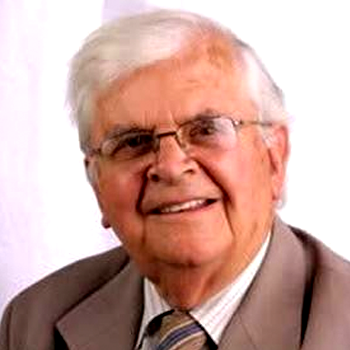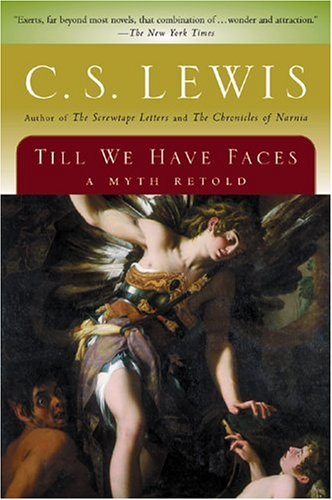Back to series
Gifted With Personhood



C.S. Lewis's Concern for the Future of Humanity
Click here to open a Print Friendly PDF
Between 1947 and 1956, I was privileged to meet with C.S. Lewis in a group convened by Nicholas Zernov, Spalding Lecturer of Russian History at Oxford. I shared an apartment with Nicholas for seven years, and we entertained the group in our home together. After he published his novel, Till We Have Faces, I asked Lewis on one occasion, of all the books he had written, what did he consider the most important Christian message he had given? With no hesitation, his reply was, “the three lectures I gave at Newcastle on The Abolition of Man, in 1942-43, together with my recent novel, Till We Have Faces” (1956). I think he already sensed disappointment that the latter novel was being scarcely noticed. Certainly, there was no reprint as long as he lived—another seven years. Nor did his three lectures to the Faculty of Education in the University of Newcastle make any headlines.
 If anything, they seemed an exaggeration on the threat of technology in society. Only later, did the popular book by C. P. Snow, The Two Cultures, as that of science and the humanities, arouse more popular debate. Part of the apathy over Lewis’s topics was the reputed traditional bias of Oxford colleges as the bastion of the classical humanities, unlike Cambridge, with science having only marginal influence until World War II. So it could be argued that Lewis’s science fiction, especially That Hideous Strength, was what an entrenched, traditional Oxford don would write about; the intrusion of young science fellows entering into college life. Ironically, Winston Churchill selected an Oxford scientist, Lord Cherwell, to intensify the role of science into warfare, as it had never been exploited before. England might not nationally have survived without this new penetration of technology into society.
If anything, they seemed an exaggeration on the threat of technology in society. Only later, did the popular book by C. P. Snow, The Two Cultures, as that of science and the humanities, arouse more popular debate. Part of the apathy over Lewis’s topics was the reputed traditional bias of Oxford colleges as the bastion of the classical humanities, unlike Cambridge, with science having only marginal influence until World War II. So it could be argued that Lewis’s science fiction, especially That Hideous Strength, was what an entrenched, traditional Oxford don would write about; the intrusion of young science fellows entering into college life. Ironically, Winston Churchill selected an Oxford scientist, Lord Cherwell, to intensify the role of science into warfare, as it had never been exploited before. England might not nationally have survived without this new penetration of technology into society.
But Lewis was aware and alarmed by the wholesale acceptance of technology. He saw it was becoming a new threat to our humanum. As he observed: “Each new power won by man is a power over man. Each advance leaves him weaker as well as stronger.”1 The notion of “Man’s Power over Nature turns out to be a power exercised by some men over other men with Nature as its instrument.” It remained later for Jacques Ellul to further see the entrapment of modern society within the relentless growth of “technique for technique’s sake.”
Why Myth?
One early reviewer described his novel Till We Have Faces as “brilliantly offbeat.” Only Chad Walsh, in the New York Herald Tribune, declared it to be “the most significant and triumphant work that Lewis has yet produced.” But Lewis was already dead by then. The deliberate choice of pagan mythology as his genre in his novel Till We Have Faces was to suggest that a good classical pagan was closer to the apostle Paul than a liberal secularist is today. For, at least, there was the dominating presence of the “sacred,” the awareness of good and evil, the sense of mystery, an after-life, and of moral accountability. Myth is associated with the lack of differentiation, of earth and heaven, man and beast, with scope for the heroic which leaves the human and the divine indeterminate. This is cause for chaos and violence. But at least mythopoeia leaves space to see that things are not as they might appear, for multiple layers of meanings, and thus always a challenge to our over-confident claims to “know” what is “reality.” It is a sphere beloved of the literary critic. So it was left to later novelists such as William Golding and Saul Bellow to complain against the loss of all mystery in a technical society, because with this loss no “space” was allowable to what is indeterminate in myth. Yet we cannot be “human” without it.
In this context, often in our discussions, Lewis would speak about the tension required to see through the clean window, without losing the perspective of also looking at the view. A culture dominated by psycho-analysis, would end up seeing nothing. You simply cannot afford to explain everything away. So Lewis would challenge us today, how much mystery has been lost in a secular society? As I write, it is ironic that in the same month (January 2006), we have the Encyclical of Pope Benedict XVI on the love of God, and the National Geographic article on the brain chemistry of love, as a clash of two mindsets, about the realm of God, and the materialist realm of sex, that is of “mystery” and of “no mystery!”
In his novel then, Till We Have Faces, Lewis adopts the universal awareness of “the numinous” in primitive religion. This is where humans cannot breach the mystery of divinity by ordinary perception. Lewis takes the seriousness of myth as expressive of a great sovereign, unconditional Reality at the core of all things. Myth, too, is the way the shadow of the inexpressible can be vocalized, like beams of light from an immense but far distant source. There are several truly human themes of myth that Lewis sees: 1) humanity should worship; 2) human dependency is upon God (the gods); 3) scape-goating is basic to human fallenness; 4) blood is the appropriate symbol of life and its sacrifice; 5) it is appropriate one should die for the sake of the people; 6) consolation is found in the religious life, whether symbolized by temple or other sacred site; 7) bearing one another’s burdens, is expressive of being a personal being; 8) sins of jealousy, envy, and pride destroy relationships, human and divine; 9) redemption requires dealing with the past, as well as the present, such as is evidenced in family legacies; 10) re-birth requires a willing death.
As Lewis stated, myth became fact in the Incarnation. Now as myth transcends thought, Incarnation transcends “myth” as indeed it transcends “fact”. So Lewis concluded we ought not to be ashamed of the mythical radiance cast over our theological faith, indeed of our wonder and joy. Scholars are reluctant to accept such premises, since myth has been traditionally associated with unreality, whereas for Lewis it is necessary for awe and worship, of what is beyond our ken.
The Novel as Autobiographical
The novel is, of course, Lewis’s rewriting of the story of Cupid and Psyche in the Latin novel, Metamorphoses, or The Golden Ass, by Lucius Apuleius Platonicus. Lewis was haunted by the myth ever since he read it in preparation for his entrance exam to University College, Oxford, in 1917. Following on the poems of William Morris and Robert Bridges, Lewis began to compose an unfinished poem on the myth in 1923, called Dymer. When eventually he wrote about it in his last novel, Till We Have Faces, the story had become deeply autobiographical. He acknowledges that Orual’s tutor, the Greek slave, “The Fox,” is very much the “academic,” showing ambiguously his love of poetry, and yet his rationalistic fears of rousing the emotions by it. Lewis acknowledged, “I’m much with the book.”
Until we have each one received God’s transforming love within us, we are all like Orual, called through nature, conscience, myths, believers’ testimonies, miracles, voices within and circumstances without, and above all, by the personal transformation of one so closely beloved, as Psyche was to Orual, or as Joy Davidman became for Lewis, to whom he dedicated the novel.
When Lewis first tried to compose his poem of Cupid or eros and Psyche or agape, of what is humanly desirous and of what is divinely given, he states,
I ended my first book, with the words ‘no answer.’ I know now O Lord, why you utter no answer. You yourself are the answer. Before your face questions die away. What other answer would suffice? Only words, words, words; to be led out to battle against other words. Long did I hate you, long did I fear you.2
Till We Have Faces is then descriptive of the frustrations we share within our natural, human condition, until we meet the face of God, in life through death and resurrection. It is a life journey.
Central to the plot of the novel is Orual, the king’s oldest daughter, with her two younger stepsisters, Redival, who never understands Psyche, the youngest sister. But Orual believes she loves Psyche dearly. Changing emotional triangles within the palace and royal family generate much of the story-plot. At the heart of it all is Orual’s misconstrual of “love” for Psyche, her adored sister, and of Psyche’s contrasted understanding of love. Early on, Psyche confesses to Orual, that all her old longings were removed; for everything before was a dream.3 Then she invites her sister to come to her—for she is not her own.4 Orual responds confusedly, because she sees that Psyche is teaching her about kinds of love she did not know.5
Later, when she meets again her sister, who she thought was dead, now alive again, Orual confesses that she was telling her about so many wonders. They made her feel she had been wrong all her life. So everything had to be begun all over again.6 Then at the end of the narration, as told by Orual, she says: “Psyche, never again will I call you mine; but all there is of me shall be yours.” Now Orual realized she never had one selfless thought of her. She was a craver of selfish desires, an erotic indeed!7
 As every Christian learns with the experience of Nicodemus, or of Psyche, being “born again” is when we become more alive, only by the experience of “death to the self.” Indeed, we discover we become “most ourselves” when we are “most in Christ Jesus.” So, as Orual begins this dying process to “her old self,” she sees her sister being “the old Psyche still.” But she has become a thousand times more her very self than she had ever been before her sacrifice. Now Orual sees “a real woman,” as she had never seen before.8 This now encourages Orual to follow, but in alarm she realizes she is being un-made, to be no one. Then she is amazed to find she has become Psyche, also.9
As every Christian learns with the experience of Nicodemus, or of Psyche, being “born again” is when we become more alive, only by the experience of “death to the self.” Indeed, we discover we become “most ourselves” when we are “most in Christ Jesus.” So, as Orual begins this dying process to “her old self,” she sees her sister being “the old Psyche still.” But she has become a thousand times more her very self than she had ever been before her sacrifice. Now Orual sees “a real woman,” as she had never seen before.8 This now encourages Orual to follow, but in alarm she realizes she is being un-made, to be no one. Then she is amazed to find she has become Psyche, also.9
Personal unreality, Lewis symbolizes, is the wearing of masks, just as collegial life at Oxford was full of masks, as indeed any royal court is full of them. For the roles we wear ambitiously make us all “personages” instead of being real persons. But for Lewis it also echoed a long remembered remark he had from his own adolescence, that he was the kind of person who gets told, “And take that look off your face too.” Orual first discovered she was ugly relationally, as a child, “when her father, the King, ordered that she and her companions wear veils, ‘and good thick veils too.’” One of the other girls tittered, and Orual realized that was the first time she clearly understood she was ugly.10
When the King without a male descendent hears he has a third daughter, he sees accusing faces everywhere all gaping at his intense frustration.11 Likewise the vestal girls, attending the priest in his grisly religious duties, have their faces so heavily painted, that they appear only as masked figures. When Psyche is offered for sacrifice as the scape-goat, her face too, is unrecognizable behind the heavy paint.12 Then as the royal tyrant lies dying, always so self-centered, Orual reported seeing him with a terrified, idiotic, almost an animal’s face.13 Real people do not wear masks, for expressions of true love are always transparent. Eventually Orual asks the question (which is the title of the novel): “How can they [i.e., the gods] meet us face to face, until we have faces?”14
Augustine, whom Lewis admired so much, states at the end of his great work, de Trinitate, XV, 51, “Let me seek your face always….Let me remember you, let me understand you, let me love you. Increase these things in me, until you restore me to wholeness.” We “see God” in becoming bare-faced, stripped of all our pretensions of fear and pride before him, indeed as the Beatitude expresses it, “pure in heart,” stripped of all our masks. Personal transformation as Psyche experienced was expressive also for Augustine, as a function of one’s relationship with God.
Gifted With Personhood
Postmodern philosophers, under the dominating influence of Heidegger, have been preoccupied with the nature and affirmation of the human identity. A major issue concerns the primacy of ipseity over alterity. These are the Latin nouns for when I speak of my “self” and when I speak of “the other.” Simply contrasted, a narcissistic culture accepts ipseity as the belief that one is basically self-contained; hence the cult of self-fulfilment. Whereas alterity, as developed by Levinas, gives primacy to being relational and social. Freud represents the first approach, of interpreting the decisive factors of personality as intra-personal, whereas Jacques Lacan, and much of the therapeutic movement today, interprets them inter-personally. For the small baby, the attestation of the mother’s face leads from “smile, to burp, to fart,” helping the child to become a valorized self, provided there is attentiveness and unconditional acceptance.
Many of my students have been directed to read Till We Have Faces. One wrote to me about her transforming awareness of receiving her identity as the gift of God’s attentive love. “I left my ‘self’—home, family, job—in order to find myself, like the Prodigal Son. This was because I did not feel that my identity was acceptable to my parents, or that I was ‘OK,’ the way I was [like Orual]. In order to try and find myself, I re-invented myself, and then discovered there was an enormous gap between the self I had invented and the true self. Despair swamped me, as I realized I did not succeed either with the self I tried to leave behind, or with the self I had tried to re-invent.”
Orual, on assuming the role of Queen of Glome, became more and more “the Queen,” and “Orual had less and less.” She then locked Orual up or laid her asleep as best she could somewhere deep down inside her.15 Later she realized that she had been so wounded relationally that all her life she had spent trying to stanch her bleeding heart.16 Journal-keeping often helps us gain more self-understanding, so Orual’s account of the novel gave her personal insights. But they became terrifying revelations of her self. For she discovered how self-centered all her life had been, to the point of destroying her faithful servant Bardia in his selflessness for her.
Now she was “empty,” only “a gap.”17 In dreams that follow, Orual discovered her whole life had been like forms of cannibalism, eating other people up that she thought she loved, only to abuse and use them for her own narcissistic purposes. She was wholly a “craver” who had to be “unmade,” to become as “no one” in herself, only gifted “to be,” by true love beyond her control.
The confession of Orual is the tragic narration of Everyone. It expresses the incapacity of the human being to exercise love properly, without the capacity of God’s love within us.18 Only humans live with “mythopeia,” because of their “sinful” confusion to know their moral limits, when they also experience transcendence. The classical notion that potency lies in “being,” has become our “natural” way of giving ourselves credit for powers beyond our sinful incapacity. [As Lewis explained in his essay on “Nature,” the Greek physis as “a coming-to-be,” was linked, with the Latin natura, the biological connotation of birth and growth.19 ] But Lewis anticipated with fear the further blindness which ensues when the advances of technology further extend human hubris, with the delusion of an endlessly expanding capacity to his selfhood. Thus Till We Have Faces challenges us deeply. It also helps to explain the contemporary conflicts and chaos of our lives and of so much confusion within our society today.

James M. Houston
Professor, CSLI Co-Founder, Senior Fellow for Faith and Vocation, CSLI James M. Houston is a co-founder of the C.S. Lewis Institute. From its beginning, Jim has served as a Senior Fellow of the Institute, lecturing at CSLI events over the past four decades. He received his Bachelor of Science and M.A. degrees from the University of Edinburgh and a D. Phil. from Oxford University. He was a University Lecturer at Oxford from 1947 – 1971 where he taught cultural and historical geography. While teaching at Oxford, he met C.S. Lewis and participated in a regular Bible study with him for six years. He is known as one of the “founding fathers” of Regent College in Vancouver, British Columbia where he has served as the first Principal, Chancellor and Professor of Spiritual Theology.
 COPYRIGHT: This publication is published by C.S. Lewis Institute; 8001 Braddock Road, Suite 301; Springfield, VA 22151. Portions of the publication may be reproduced for noncommercial, local church or ministry use without prior permission. Electronic copies of the PDF files may be duplicated and transmitted via e-mail for personal and church use. Articles may not be modified without prior written permission of the Institute. For questions, contact the Institute: 703.914.5602 or email us.
COPYRIGHT: This publication is published by C.S. Lewis Institute; 8001 Braddock Road, Suite 301; Springfield, VA 22151. Portions of the publication may be reproduced for noncommercial, local church or ministry use without prior permission. Electronic copies of the PDF files may be duplicated and transmitted via e-mail for personal and church use. Articles may not be modified without prior written permission of the Institute. For questions, contact the Institute: 703.914.5602 or email us.
-
Recent Podcasts
From Politics to Pampers
by Michelle Morgan Knott, Aimee Riegert on November 15, 2024A stay-at-home mom shares life and spiritual lessons...Read More
-
An Unexpected Change – David Westerhoff’s Story
by David Westerhoff on November 8, 2024
-
The Faith of Jonathan Edwards
by Aimee Riegert, Arthur W. Lindsley on November 1, 2024
-
Recent Publications
Will You Be Ready?
by Thomas A. Tarrants on October 23, 2024Tom Tarrants gives insights on how we can...Read More
-
Should Christians Be Involved with Politics?
by Kerry A. Knott on October 1, 2024
-
Isn ’t Atheism Based on Scientific Fact Whereas Christianity is Based on “Faith”?
by Cameron McAllister on September 1, 2024
0
All Booked
0.00
All Booked
0.00
All Booked
23169
ADVENT CALENDAR: The Amazing Prophecies Fulfilled by the Birth of Jesus Christ
https://www.cslewisinstitute.org/?event=advent-calendar-the-amazing-prophecies-fulfilled-by-the-birth-of-jesus-christ&event_date=2024-11-28®=1
https://www.paypal.com/cgi-bin/webscr
2024-11-28

Next coming event
Days
Hours
Minutes
Seconds
ADVENT CALENDAR: The Amazing Prophecies Fulfilled by the Birth of Jesus Christ
On November 28, 2024 at 6:00 amCategories
Speakers

James M. Houston
Professor, CSLI Co-Founder, Senior Fellow for Faith and Vocation, CSLI
Team Members

James M. Houston
Professor, CSLI Co-Founder, Senior Fellow for Faith and Vocation, CSLIJames M. Houston is a co-founder of the C.S. Lewis Institute. From its beginning, Jim has served as a Senior Fellow of the Institute, lecturing at CSLI events over the past four decades. He received his Bachelor of Science and M.A. degrees from the University of Edinburgh and a D. Phil. from Oxford University. He was a University Lecturer at Oxford from 1947 – 1971 where he taught cultural and historical geography. While teaching at Oxford, he met C.S. Lewis and participated in a regular Bible study with him for six years. He is known as one of the “founding fathers” of Regent College in Vancouver, British Columbia where he has served as the first Principal, Chancellor and Professor of Spiritual Theology.




